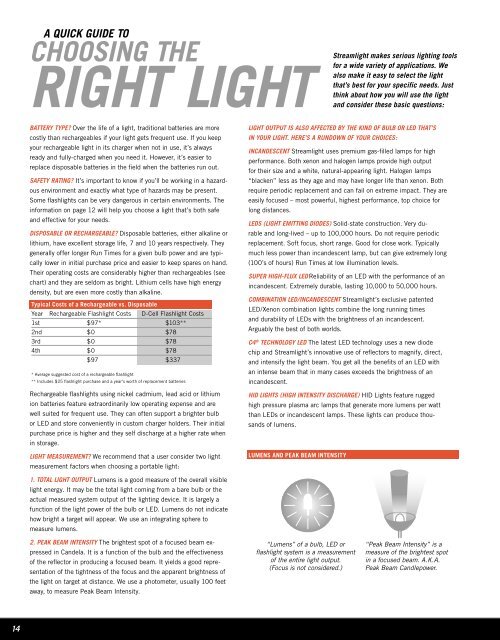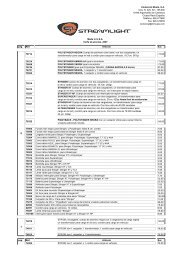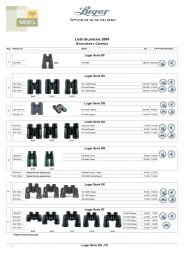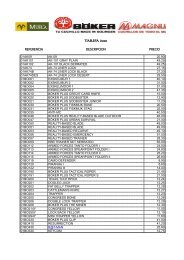Streamlight :: Illumination Tools :: Full-Line Catalog :: 2009
Streamlight :: Illumination Tools :: Full-Line Catalog :: 2009
Streamlight :: Illumination Tools :: Full-Line Catalog :: 2009
You also want an ePaper? Increase the reach of your titles
YUMPU automatically turns print PDFs into web optimized ePapers that Google loves.
14<br />
A QUICK GUIDE TO<br />
CHOOSING THE<br />
RIGHT LIGHT<br />
BATTERY TYPE? Over the life of a light, traditional batteries are more<br />
costly than rechargeables if your light gets frequent use. If you keep<br />
your rechargeable light in its charger when not in use, it’s always<br />
ready and fully-charged when you need it. However, it’s easier to<br />
replace disposable batteries in the field when the batteries run out.<br />
SAFETY RATING? It’s important to know if you’ll be working in a hazardous<br />
environment and exactly what type of hazards may be present.<br />
Some flashlights can be very dangerous in certain environments. The<br />
information on page 12 will help you choose a light that’s both safe<br />
and effective for your needs.<br />
DISPOSABLE OR RECHARGEABLE? Disposable batteries, either alkaline or<br />
lithium, have excellent storage life, 7 and 10 years respectively. They<br />
generally offer longer Run Times for a given bulb power and are typically<br />
lower in initial purchase price and easier to keep spares on hand.<br />
Their operating costs are considerably higher than rechargeables (see<br />
chart) and they are seldom as bright. Lithium cells have high energy<br />
density, but are even more costly than alkaline.<br />
Typical Costs of a Rechargeable vs. Disposable<br />
Year Rechargeable Flashlight Costs D-Cell Flashlight Costs<br />
1st $97* $103**<br />
2nd $0 $78<br />
3rd $0 $78<br />
4th $0 $78<br />
$97 $337<br />
* Average suggested cost of a rechargeable flashlight<br />
** Includes $25 flashlight purchase and a year’s worth of replacement batteries<br />
Rechargeable flashlights using nickel cadmium, lead acid or lithium<br />
ion batteries feature extraordinarily low operating expense and are<br />
well suited for frequent use. They can often support a brighter bulb<br />
or LED and store conveniently in custom charger holders. Their initial<br />
purchase price is higher and they self discharge at a higher rate when<br />
in storage.<br />
LIGHT MEASUREMENT? We recommend that a user consider two light<br />
measurement factors when choosing a portable light:<br />
1. TOTAL LIGHT OUTPUT Lumens is a good measure of the overall visible<br />
light energy. It may be the total light coming from a bare bulb or the<br />
actual measured system output of the lighting device. It is largely a<br />
function of the light power of the bulb or LED. Lumens do not indicate<br />
how bright a target will appear. We use an integrating sphere to<br />
measure lumens.<br />
2. PEAK BEAM INTENSITY The brightest spot of a focused beam expressed<br />
in Candela. It is a function of the bulb and the effectiveness<br />
of the reflector in producing a focused beam. It yields a good representation<br />
of the tightness of the focus and the apparent brightness of<br />
the light on target at distance. We use a photometer, usually 100 feet<br />
away, to measure Peak Beam Intensity.<br />
<strong>Streamlight</strong> makes serious lighting tools<br />
for a wide variety of applications. We<br />
also make it easy to select the light<br />
that’s best for your specific needs. Just<br />
think about how you will use the light<br />
and consider these basic questions:<br />
LIGHT OUTPUT IS ALSO AFFECTED BY THE KIND OF BULB OR LED THAT’S<br />
IN YOUR LIGHT. HERE’S A RUNDOWN OF YOUR CHOICES:<br />
INCANDESCENT <strong>Streamlight</strong> uses premium gas-filled lamps for high<br />
performance. Both xenon and halogen lamps provide high output<br />
for their size and a white, natural-appearing light. Halogen lamps<br />
“blacken” less as they age and may have longer life than xenon. Both<br />
require periodic replacement and can fail on extreme impact. They are<br />
easily focused – most powerful, highest performance, top choice for<br />
long distances.<br />
LEDS (LIGHT EMITTING DIODES) Solid-state construction. Very durable<br />
and long-lived – up to 100,000 hours. Do not require periodic<br />
replacement. Soft focus, short range. Good for close work. Typically<br />
much less power than incandescent lamp, but can give extremely long<br />
(100’s of hours) Run Times at low illumination levels.<br />
SUPER HIGH-FLUX LED Reliability of an LED with the performance of an<br />
incandescent. Extremely durable, lasting 10,000 to 50,000 hours.<br />
COMBINATION LED/INCANDESCENT <strong>Streamlight</strong>’s exclusive patented<br />
LED/Xenon combination lights combine the long running times<br />
and durability of LEDs with the brightness of an incandescent.<br />
Arguably the best of both worlds.<br />
C4 ® TECHNOLOGY LED The latest LED technology uses a new diode<br />
chip and <strong>Streamlight</strong>’s innovative use of reflectors to magnify, direct,<br />
and intensify the light beam. You get all the benefits of an LED with<br />
an intense beam that in many cases exceeds the brightness of an<br />
incandescent.<br />
HID LIGHTS (HIGH INTENSITY DISCHARGE) HID Lights feature rugged<br />
high pressure plasma arc lamps that generate more lumens per watt<br />
than LEDs or incandescent lamps. These lights can produce thousands<br />
of lumens.<br />
LUMENS AND PEAK BEAM INTENSITY<br />
“Lumens” of a bulb, LED or<br />
flashlight system is a measurement<br />
of the entire light output.<br />
(Focus is not considered.)<br />
“Peak Beam Intensity” is a<br />
measure of the brightest spot<br />
in a focused beam. A.K.A.<br />
Peak Beam Candlepower.






